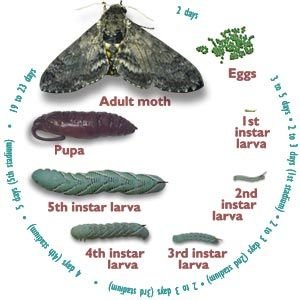
If you’ve ever encountered these green caterpillars munching on tomato plants, you’re not alone! Often confused with garden pests, hornworms are more than just a nuisance; they have an incredible lifecycle that showcases the beauty of nature. Let’s dive into the journey of the hornworm, exploring each stage along the way.
What Are Hornworms?
Hornworms are the larval stage of particular moth species, mainly the **Tuta absoluta** and the **Manduca sexta**. You might find them lounging on the leaves of tomato, tobacco, and eggplants, where they feast on the plant’s foliage.
These caterpillars are notable for their large size and distinctive horn-like projection on their rear. The horn isn’t dangerous, but it certainly adds character! It’s a bit like wearing a funky hat – it makes them unforgettable. Here’s a fun fact: hornworms can grow up to four inches long! That’s a decent-sized snack if you’re a bird.
Knowing what hornworms are and understanding their lifecycle can help you appreciate the roles they play in the ecosystem, even if they sometimes cause a little trouble in your garden.
The Egg Stage: The Beginning of Life
The hornworm’s story begins as a tiny egg laid on the underside of host plant leaves. Each female moth can lay up to **300 eggs**, which is quite a lot for such small creatures! These eggs are round and usually pale in color, blending in well with the leaves.
After about **4 to 10 days**, the eggs hatch, and out come the tiny larvae—ready to munch! You might picture them like tiny green popcorn kernels popping out on a warm summer day. At this stage, the hornworms are vulnerable, relying on their camouflage to avoid predators.
It’s kind of like playing hide and seek, where staying still and blending in is key! The importance of this stage cannot be overstated; it’s the foundation for everything that comes next.
Larval Stage: Growing Up Fast
Once hatched, hornworms enter their larval stage, which is where the real magic happens. During this period, which lasts about **2 to 3 weeks**, they grow rapidly by chewing on plant leaves. You can practically see them growing before your eyes!
In this stage, hornworms undergo several molts, shedding their skin to accommodate their increasing size. Each time they molt, they look more and more like the big, green caterpillars we’re familiar with. This phase is crucial because it’s all about gathering energy and nutrients to fuel their transformation into moths.
As they feed, they also produce frass (that’s just a fancy term for caterpillar poop). You might notice little black pellets around your plants. It’s their way of marking their territory. If you have a garden, keep an eye out for these signs, as they can indicate how much munching is going on!
Pupal Stage: The Transformation Begins
After the larval phase, the hornworm is ready for a big change. They find a safe, hidden place, usually beneath the soil or on plant debris, and enter the **pupal stage**. This is a critical time because they’re no longer munching away; instead, they are preparing for the next chapter of their life.
Inside the pupal casing, the hornworm undergoes **metamorphosis**—a complete transformation from caterpillar to moth. It’s like going to sleep as one creature and waking up as another. This process can take anywhere from **7 to 14 days**, depending on environmental conditions.
During this time, great changes are taking place. Their bodies are breaking down and reforming. This stage might feel a bit like being in a cocoon of dreams—inner changes that aren’t visible to the outside world yet.
Adult Moth Stage: A New Life Awaits
Finally, the moment comes when the adult moth emerges from its pupal casing. At first, it’s soft and crumpled, needing time to dry and expand its wings. The transformation is complete, and a beautiful moth is now in the world.
Hornworms commonly become **sphinx moths**, known for their impressive size and striking patterns. These adult moths don’t eat like their caterpillar counterparts; instead, they focus on mating and laying eggs to continue the cycle.
Besides being stunning to look at, adult moths are also important pollinators. They help plants reproduce while searching for nectar at night, showcasing how each life stage contributes to the ecosystem. It’s a reminder that every stage of life has its purpose, even when it’s just a loop in a much larger cycle.
Why Understanding the Lifecycle Matters
So, you might be wondering, why should we care about the lifecycle of the hornworm? For gardeners, knowing this lifecycle is essential. Understanding when to expect hornworms can help you protect your plants before they do too much damage.
You can take action like:
- Checking plants regularly for eggs and larvae
- Using natural predators like birds to control hornworm populations
- Implementing organic pesticides if necessary
Plus, appreciating the lifecycle of these creatures helps us see the bigger picture in nature. It highlights the beauty of transformation and resilience, reminding us that every creature, no matter how small, has a role to play.
Final Thoughts on the Hornworm Lifecycle
The journey of the hornworm— from tiny egg to majestic moth—is a fascinating tale of growth, change, and survival. Every stage of their lifecycle is interconnected, showing us the beauty and complexity of the natural world.
Next time you spot a hornworm, take a moment to appreciate its journey. Whether you’re a gardener or simply an insect enthusiast, knowing about their lifecycle gives you a deeper understanding of what goes on behind the scenes. Remember, nature is full of incredible transformations, and the hornworm is just one of many stories waiting to be uncovered!
